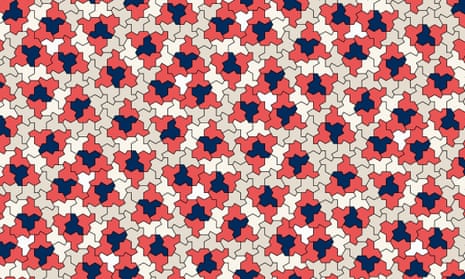One of mathematics’ most intriguing visual mysteries has finally been solved – thanks to a hobbyist in England.
The conundrum: is there a shape that can be arranged in a tile formation, interlocking with itself ad infinitum, without the resulting pattern repeating over and over again?
In nature and on our bathroom walls, we typically see tile patterns that repeat in “a very predictable, regular way”, says Dr Craig Kaplan, an associate professor of computer science at the University of Waterloo in Ontario. What mathematicians were interested in were shapes that “guaranteed non-periodicity” – in other words, there was no way to tile them so that the overall pattern created a repeating grid.
Such a shape would be known as an aperiodic monotile, or “einstein” shape, meaning, in roughly translated German, “one shape” (and conveniently echoing the name of a certain theoretical physicist).
“There’s been a thread of beautiful mathematics over the last 60 years or so searching for ever smaller sets of shapes that do this,” Kaplan says. “The first example of an aperiodic set of shapes had over 20,000 shapes in it. And of course, mathematicians worked to get that number down over time. And the furthest we got was in the 1970s,” when the Nobel-prize winning physicist Roger Penrose found pairs of shapes that fit the bill.
Now, mathematicians appear to have found what they were looking for: a 13-sided shape they call “the hat”. The discovery was largely the work of David Smith of the East Riding of Yorkshire, who had a longstanding interest in the question and investigated the problem using an online geometry platform. Once he’d found an intriguing shape, he told the New York Times, he would cut it out of cardstock and see how he could fit the first 32 pieces together.
“I am quite persistent but I suppose I did have a bit of luck,” Smith told the Guardian in an email.
Once he had landed on the hat, he contacted Kaplan, an associate professor of computer science at the University of Waterloo in Canada. Together they worked to confirm that the hat was indeed an einstein shape, and early this year they enlisted the help of two others – Dr Chaim Goodman-Strauss, a University of Arkansas mathematician, and Dr Joseph Myers, a software developer in Cambridge, England.
Kaplan and Smith had gotten about “halfway through the problem”, and Goodman-Strauss and Myers “were able to sort of fill in the rest of the puzzle and provide the rest of a proof”, Kaplan says. One proof was more traditional, hinging on demonstrating that the shape behaved according to a certain set of rules. The other, which Myers came up with, is more “esoteric”, Kaplan says: it “follows a brand new line of attack that we haven’t seen before. And we’re particularly excited about that.”
That second proof was fueled by another stunning finding: after discovering “the hat”, Smith landed on another shape that did the same job and looks a bit like a turtle. Myers found that the turtle and hat were geometrically linked and led to a whole family of einstein shapes, the Times reported.
The four men are co-authors on a paper, not yet peer-reviewed, detailing their findings.
“The miracle is that this little tile disrupts order at all scales,” Goodman-Strauss says. “These tiles are just sitting next to each other and somehow have these effects at any length scale: miles, 10 miles, 100bn light years, these little guys are somehow causing effects at these arbitrary long distances.”
Cookies. I will put a cutter on Printables a bit later. pic.twitter.com/hH2E8BH7zY
— Nikolay Tumanov (@ntumanov_Xray) March 28, 2023
It’s unclear what the discovery could lead to outside the world of mathematics, but “there are lots of great real-world applications in art, design, architecture”, says Kaplan. “The race is on to be the first person to take a photo of their bathroom floor tiled in hats.” Smith says it could help in studying structures known as quasicrystals. And outside interest in the finding has ballooned.
“I’ve just been blown away by the outpouring of interest and people making their own tiles, their own drawings – somebody made cookies in the form of this thing and quilts,” Goodman Strauss says. “To me, the human aspect of this is really incredibly gratifying, that there’s all these people coming together and enjoying this thing, and it really means that this thing is gonna live for quite a long time.”

Comments (…)
Sign in or create your Guardian account to join the discussion